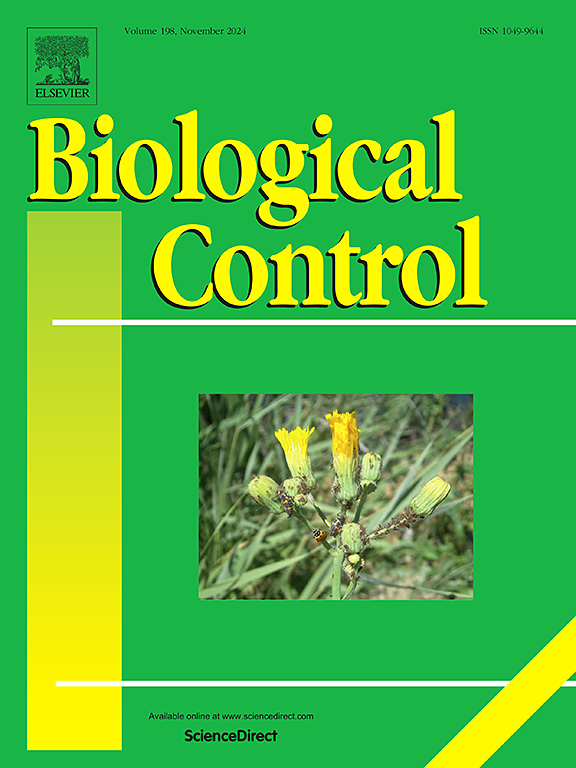Climatic suitability and potential distribution of earleaf acacia and its candidate biological control agent Trichilogaster sp
IF 3.4
2区 农林科学
Q2 BIOTECHNOLOGY & APPLIED MICROBIOLOGY
引用次数: 0
Abstract
Acacia auriculiformis A. Cunn. ex Benth. (Fabaceae), commonly known as earleaf acacia (ELA), is an invasive evergreen tree introduced to the USA from its native subtropical forests in Australia, Papua New Guinea, and Indonesia. Since its introduction to the United States in the 1930s, ELA has spread across Florida and Hawaii, and it has the potential to invade further climatically suitable regions. This study utilizes ecological niche modeling (ENM) to predict the potential distribution of ELA across the Caribbean, Central America, and North America, and assess the climatic suitability of Florida for the candidate biological control agent, Trichilogaster sp. nov., a gall-forming wasp. Earleaf acacia occurrence data were sourced from surveys and databases and Trichilogaster sp. nov. occurrence data were sourced from native range surveys. Ecological niche models were created using the ‘maxnet’ algorithm in the ‘ENMEval’ R package with appropriate environmental variables. The results indicate that a variety of regions across the Americas, including Florida and Louisiana in the United States, as well as Mexico, Belize, Guatemala, El Salvador, Honduras, Nicaragua, Costa Rica, and Panama have climates suitable for ELA. For Trichilogaster sp. nov., the model forecasts suitable climatic conditions in southern Florida and along the east coast of the USA. Both models exhibit high predictive accuracy, with AUC values above 0.9. This study emphasizes the need for continued monitoring and management of ELA and evaluates areas in Florida predicted to have suitable climatic conditions for Trichilogaster sp. nov. If it is approved for release as a biocontrol agent in Florida. Our findings contribute to understanding the potential distribution of ELA in North America and offers insights into potential management strategies using its co-evolved natural enemy Trichilogaster sp. nov as a biological control agent.
金合欢及其候选生物防治剂Trichilogaster sp的气候适宜性和潜在分布
金合欢Benth交货。(Fabaceae),俗称earleaf acacia (ELA),是一种入侵常绿乔木,从澳大利亚,巴布亚新几内亚和印度尼西亚的原生亚热带森林引入美国。自20世纪30年代被引入美国以来,ELA已经蔓延到佛罗里达州和夏威夷,并且有可能进一步入侵气候适宜的地区。本研究利用生态位模型(ENM)预测了ELA在加勒比海、中美洲和北美的潜在分布,并评估了佛罗里达州对候选生物防治剂Trichilogaster sp. nov.(一种形成瘿的黄蜂)的气候适宜性。耳叶金合欢的发生数据来源于调查和数据库,毛缕草的发生数据来源于原生地调查。利用“ENMEval”R软件包中的“maxnet”算法建立生态位模型,并采用适当的环境变量。结果表明,美洲的许多地区,包括美国的佛罗里达州和路易斯安那州,以及墨西哥、伯利兹、危地马拉、萨尔瓦多、洪都拉斯、尼加拉瓜、哥斯达黎加和巴拿马,都有适合ELA的气候。对于滴虫,该模型预测了佛罗里达州南部和美国东海岸的适宜气候条件。两种模型均具有较高的预测精度,AUC值均在0.9以上。本研究强调了对ELA的持续监测和管理的必要性,并评估了佛罗里达州预计具有适合11月毛滴虫的气候条件的地区,如果它被批准在佛罗里达州作为生物防治剂释放。我们的研究结果有助于了解ELA在北美的潜在分布,并为利用其共同进化的天敌Trichilogaster sp. nov作为生物防治剂的潜在管理策略提供见解。
本文章由计算机程序翻译,如有差异,请以英文原文为准。
求助全文
约1分钟内获得全文
求助全文
来源期刊

Biological Control
生物-昆虫学
CiteScore
7.40
自引率
7.10%
发文量
220
审稿时长
63 days
期刊介绍:
Biological control is an environmentally sound and effective means of reducing or mitigating pests and pest effects through the use of natural enemies. The aim of Biological Control is to promote this science and technology through publication of original research articles and reviews of research and theory. The journal devotes a section to reports on biotechnologies dealing with the elucidation and use of genes or gene products for the enhancement of biological control agents.
The journal encompasses biological control of viral, microbial, nematode, insect, mite, weed, and vertebrate pests in agriculture, aquatic, forest, natural resource, stored product, and urban environments. Biological control of arthropod pests of human and domestic animals is also included. Ecological, molecular, and biotechnological approaches to the understanding of biological control are welcome.
 求助内容:
求助内容: 应助结果提醒方式:
应助结果提醒方式:


